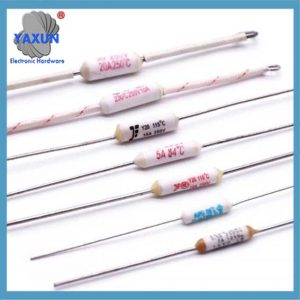Termékkategóriák
- hőbiztosíték 32
- felületre szerelhető biztosítékok 12
- termisztor 36
- PCB-re szerelhető biztosítéktartó 27
- Kábelköteg 6
- Penge biztosítéktartók 17
- termosztát 50
- Elektromos biztosíték 24
- Autóipari hőmérsékleti érzékelő 7
- Termikus áramkör megszakító 22
- Biztosítékdoboz-tartó 36
- Hőmérséklet érzékelő 75
- Hőkapcsoló 68
- Autó biztosíték 20
- Csavarja le a biztosítékokat 8
Termékcímkék
Arlin F00240C 10A 240C hőbiztosíték GHD hajegyenesítőhöz
A termikus biztosíték egy nagyon gyakori elektronikus alkatrész, amelynek célja az elektromechanikus berendezések védelme a túlmelegedésektől. It is also called over-temperature protector, overheat protection, and temperature protection. The thermal fuse is placed close to the heating part of the electromechanical equipment and connected in series to the equipment power circuit or control circuit. When the temperature of the equipment rises to the rated value of the thermal fuse for some reason, the thermal fuse automatically melts and cuts off the equipment power supply circuit to prevent the equipment from being damaged due to overheating and protect the electromechanical equipment.
 Hőbiztosíték a hajszárítóhoz, elektromos vasaló, rizsfőző, elektromos tűzhely, transzformátor, motor |
 Hőbiztosíték a hajvasaló túlmelegedés elleni védelemhez |
 Arlin F00240C 10A 240C hőbiztosíték GHD hajegyenesítőhöz |
Ahogy a neve sugallja, the thermal fuse causes the internal temperature-sensitive material of the thermal fuse close to the equipment to deform when the temperature of the electromechanical or electrical equipment rises to the operating temperature (this value is specified by the thermal fuse manufacturer when manufacturing), thereby disconnecting the power supply circuit.
1. Marking: The manufacturer’s trademark, rated voltage and rated current should be clearly marked on the 240C Thermal Fuse shell.
2. Temperature characteristics: During the test, an indicator with a current of less than 10mA is used to display the circuit on and off.
3. Névleges üzemi hőmérséklet (TF): Place the sample in a thermostat, keep it at TF-20℃ for 2 óra, and then heat it up at a rate of 0.5~1K to the melting temperature. The melting temperature should be within the deviation range.
4. Keeping temperature (TC): Place the sample in a thermostat, apply a voltage not exceeding the rated voltage, and a load current of 10A. Place it at TC-6℃ for 168 óra. After the test, the sample should not be melted or damaged.
5. Wet heat test: Place the sample at a temperature of 38-42℃, a relative humidity of 90%-95%, and a test cycle of 48 óra. After the test, perform Article 3, which should meet the requirements.
6. Cold and hot shock: Place the sample in a -18℃ low temperature box, keep it for 15 jegyzőkönyv, take it out and place it indoors for no less than 5 jegyzőkönyv, then place it in a TF-20℃ thermostat for 15 jegyzőkönyv, take it out and place it indoors for no less than 5 jegyzőkönyv. After 3 cycles of testing, perform Article 3 test, which should meet the requirements of Articles 8 és 9.
7. Internal resistance: Measured between the two lead wires within 15 minutes including the shell, the internal resistance of the sample should be less than 5mΩ.
8. Szigetelési ellenállás: After the sample is fused, the insulation resistance between the two leads measured with a 500V megohmmeter should be above 0.2MΩ.
9. Elektromos szilárdság: After the 4th test, 500V AC voltage is applied between the two leads for 1 minute, and no flashing or breakdown should occur.
10. Tension: Fix the sample and apply a 5Kg tension on the lead wire along the axial direction. After 10S, there should be no pulling or loosening.
11. Bending: Fix the sample and apply a force 6mm away from the shell. First bend the lead wire 45 degrees and return it to the initial position. There should be no breakage or cracking. (Only one end of the lead can be tested)
12. Appearance: The shell should be smooth, without cracks and mechanical damage; the lead should be bright, and the connection with the shell should be firm and not loose; the epoxy branch package should be smooth, without flow, and the lead should not be hanging on the branch.
Lépjen kapcsolatba velünk
Várom az e-mailedet, belül válaszolunk 12 óra értékes információkkal, amelyekre szüksége van.
 English
English Afrikaans
Afrikaans العربية
العربية বাংলা
বাংলা bosanski jezik
bosanski jezik Български
Български Català
Català 粤语
粤语 中文(简体)
中文(简体) 中文(漢字)
中文(漢字) Hrvatski
Hrvatski Čeština
Čeština Nederlands
Nederlands Eesti keel
Eesti keel Suomi
Suomi Français
Français Deutsch
Deutsch Ελληνικά
Ελληνικά हिन्दी; हिंदी
हिन्दी; हिंदी Magyar
Magyar Bahasa Indonesia
Bahasa Indonesia Italiano
Italiano 日本語
日本語 한국어
한국어 Latviešu valoda
Latviešu valoda Lietuvių kalba
Lietuvių kalba македонски јазик
македонски јазик Bahasa Melayu
Bahasa Melayu Norsk
Norsk پارسی
پارسی Polski
Polski Português
Português Română
Română Русский
Русский Cрпски језик
Cрпски језик Slovenčina
Slovenčina Slovenščina
Slovenščina Español
Español Svenska
Svenska ภาษาไทย
ภาษาไทย Türkçe
Türkçe Українська
Українська اردو
اردو Tiếng Việt
Tiếng Việt



